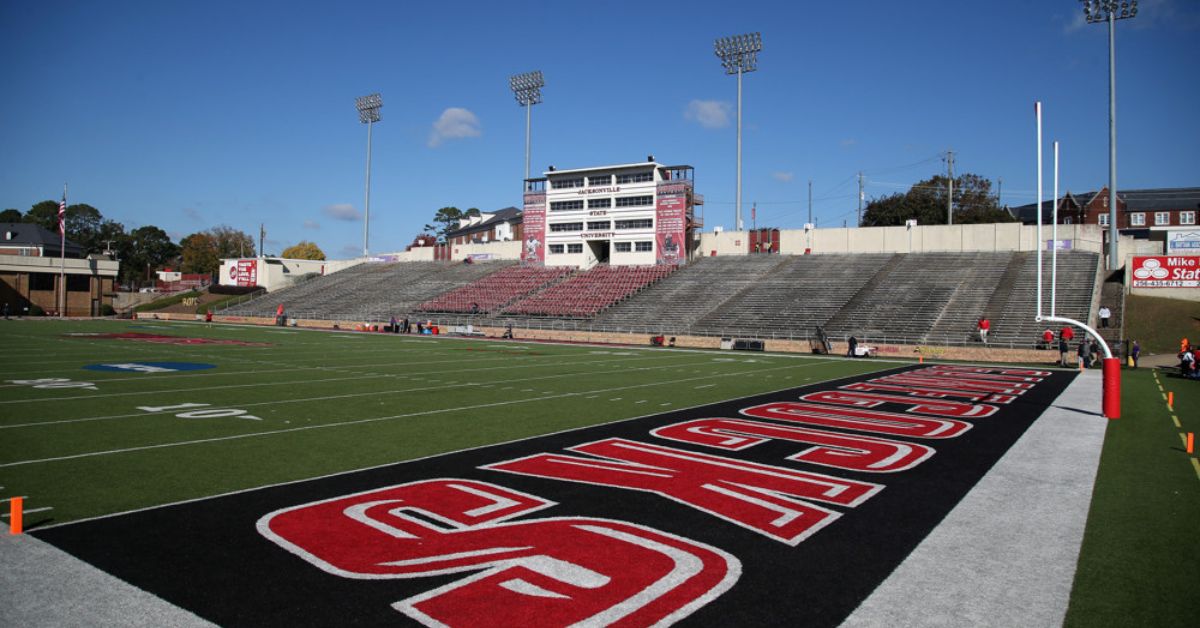Blake McCall is currently an assistant strength coach at Texas A&M. Before that, he spent two years as Director of Strength and Conditioning at Jacksonville State University. During his first year at Jax State, the team was going through an FCS to FBS transition period. In his second year (first full FBS year), the team won nine games, including a Bowl win. Before Jacksonville State, Blake spent three years at LSU working for Coach Tommy Moffitt. He worked multiple positions there, starting as an unpaid intern and working all the way up to an assistant strength coach.
(Lead image from Michael Wade/Icon Sportswire)
Freelap USA: For your teams, how do you go about fostering a culture of accountability, discipline, and commitment among the players to ensure adherence to the prescribed strength and conditioning protocols?
Blake McCall: I believe in the quote, “People don’t care how much you know until they know how much you care.” I coach with the beliefs of a servant leader.
The first thing I want to make sure the team understands is that I am there for them; they are not there for me. Coaching is a service business. I am here to provide my players with opportunities to grow and be mentored. They understand that my job is to get them better.
The first thing I want to make sure the team understands is that I’m there for THEM; they’re not there for me, says @Coach_BmcCall. Share on XWhen you put the person over the athletic value they bring and truly invest in people, they will run through a brick wall for you. To lead by example and show the type of character I want my athletes to emulate, there are some non-negotiables I establish early on to increase my point of availability.
There are two “rules” within our training program:
- I will never lie to you.
- I will never waste your time.
I will live and die by these two rules as a coach because I believe this opens an avenue for communication that connects me with the players I am training. When you open this avenue of communication, you must be prepared to have uncomfortable conversations with your players. This means showing a side of yourself and a vulnerability that may lead to uncomfortable and sensitive moments. When you show your faults and that you are a human being just like them, it allows criticism to be received in a way that promotes growth and not be perceived in an attacking manner because the athlete knows through the previous interactions you are coming from a place of love and service.
You must be able to be honest with your guys and let them know exactly what their strengths and their weaknesses are. In a world of artificial compliments, our guys look forward to the truth as long as it is presented as an opportunity to grow and get better. On top of that, every player is held accountable to the same standard. No one player is too big for the program. The head coach makes all of these “rules and standards” important throughout the entire program. Whatever the head coach deems important, the team also tends to make important.
Freelap USA: During your time at Jacksonville State, what were the biggest hurdles you faced in taking over a new program?
Blake McCall: My situation was a little different—I was walking into a new program while also being a first-time director. You will never be ready for the big chair until you are in it. I was wrong about everything I thought I had figured out.
You will never be ready for the big chair until you are in it. I was wrong about everything I thought I had figured out, says @Coach_BmcCall. Share on XFor example, I never considered taking the logistics of a weight room into account when programming—I thought it was as simple as writing out exercises and going with it. I quickly learned that you must account for where your equipment is, how much space you have, how much equipment you have, and the flow of exercise to exercise. Like many first-time bosses, I learned on the job. I understood that mistakes would be made, but I would have to continue to grow as a coach and a leader, knowing those positions are under a magnifying glass.
Working at a smaller school as a first-year head strength coach presented multiple hurdles. I realized that I was only as good as my staff and made hiring the right assistant coaches a priority. I knew I wanted to bring in an assistant who had some type of track and field background, and I also wanted to bring in an assistant who was well-versed in return-to-play procedures and modifications. I wanted to hire coaches who were way smarter than I was (I successfully did that) so that they could challenge me daily and advance the program.
This was a challenge due to the financial resources allocated to the assistant salary pool at a smaller school. Finding some hungry, young coaches was a great victory for me and the players at JSU. The coaching part was the easiest part of the whole process. Once the kids knew I cared about them, they embraced the training process and did the hard work. I was able to show them the positive results of their labor, and they were hooked, which created a highly motivated team in terms of attacking the off-season.
Freelap USA: What specific strategies have you implemented to assess the current fitness levels and physical condition of the players upon taking over a new football team in a strength and conditioning role?
Blake McCall: The first thing we did as a staff was meet with the medical staff and come up with a list of training priorities. We figured out what the big issues were from the previous season, as well as any lingering issues with current players. After those conversations, we started bucketing individuals on our roster.
Once training began, every day was a day to assess our team. Our priority was coaching technique with every lift. We would not add weight to the bar until we felt confident in the athlete’s technique. We used multiple technologies (VBT, force plate, GPS) to guide our programming and make sure that we were being responsible with load and fatigue management.
Constantly auditing the current state of the players through the technologies we possessed enabled an informed and holistic approach, as all members of the performance team could spot potential issues and provide real-time solutions to anything that may have popped up in the data. Access to the feedback technology gave us insight into how the training affected their recovery and where we needed to improve and move to the next segments of training.
Freelap USA: How did you plan to collaborate with other members of the coaching staff, such as the head coach and medical team, to ensure alignment between the strength and conditioning program and overall team strategy and player welfare?
Blake McCall: One of the first things that legend Tommy Moffitt instills in his staff is that strength and conditioning coaches are support staff. This means our responsibilities revolve around supporting the performance of players and coaches. Alignment is critical, whether it is the standards and expectations of the head coach on how he wants players to act or the type of physical qualities he deems more important for the success of his team. My job is to provide that to him.
I never wanted strength and conditioning to get in the way of football, and keeping the main thing the main thing was a target I sought to hit. Whatever direction the head coach wanted to go with the program, it was my job to figure out the best way to train the team to meet the demands of the task.
For example, Coach Rich Rod runs an extremely up-tempo offense (the fastest in the nation in 2023). That made conditioning my top priority for the team. We had to make sure that within our conditioning work, we were pinpoint accurate with the energy system we wanted to develop for that workout. I wanted to make sure that we were all “speaking the same language” between the different departments.
I also made sure to bother the position coaches only when I had information that mattered. Getting the coaches and trainers on the same page takes communication that starts with me and also takes energy and effort. When people feel like they are in the know, they tend to buy in more.
Freelap USA: What measures would you take to monitor and evaluate the effectiveness of the strength and conditioning program over time, and how would you adjust it to continually meet the evolving demands of the sport and the team’s objectives?
Blake McCall: Every day was a test day within our training program. From sprinting and jumping to conditioning and lifting—we were constantly testing. We used different technologies to check our programming to ensure we were getting bigger, faster, and stronger. We looked at a range of metrics, including max velocity, TAU, peak power, jump height, RSI, etc.
On the other end of the spectrum, we also had a system in place to ensure we were building more durable athletes and paying close attention to our load response system. We would use the players’ response metrics from the various technologies to make sure we were not overtraining but also make sure we were not undertraining. We wanted to make sure we were moving the needle in total athlete development. We wanted to push guys when they were ready to be pushed and pull the reins back when we needed to.
Since you’re here…
…we have a small favor to ask. More people are reading SimpliFaster than ever, and each week we bring you compelling content from coaches, sport scientists, and physiotherapists who are devoted to building better athletes. Please take a moment to share the articles on social media, engage the authors with questions and comments below, and link to articles when appropriate if you have a blog or participate on forums of related topics. — SF




